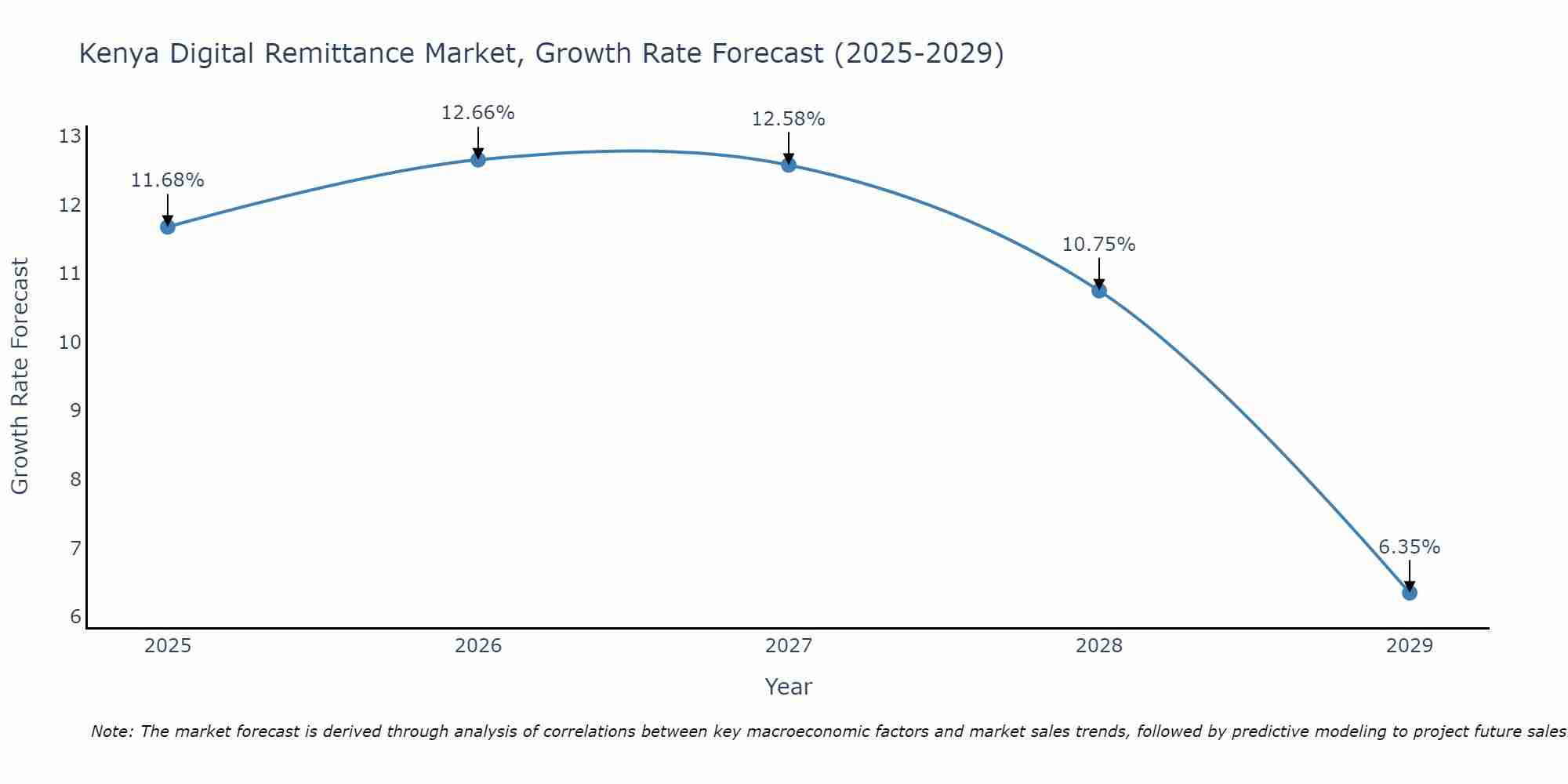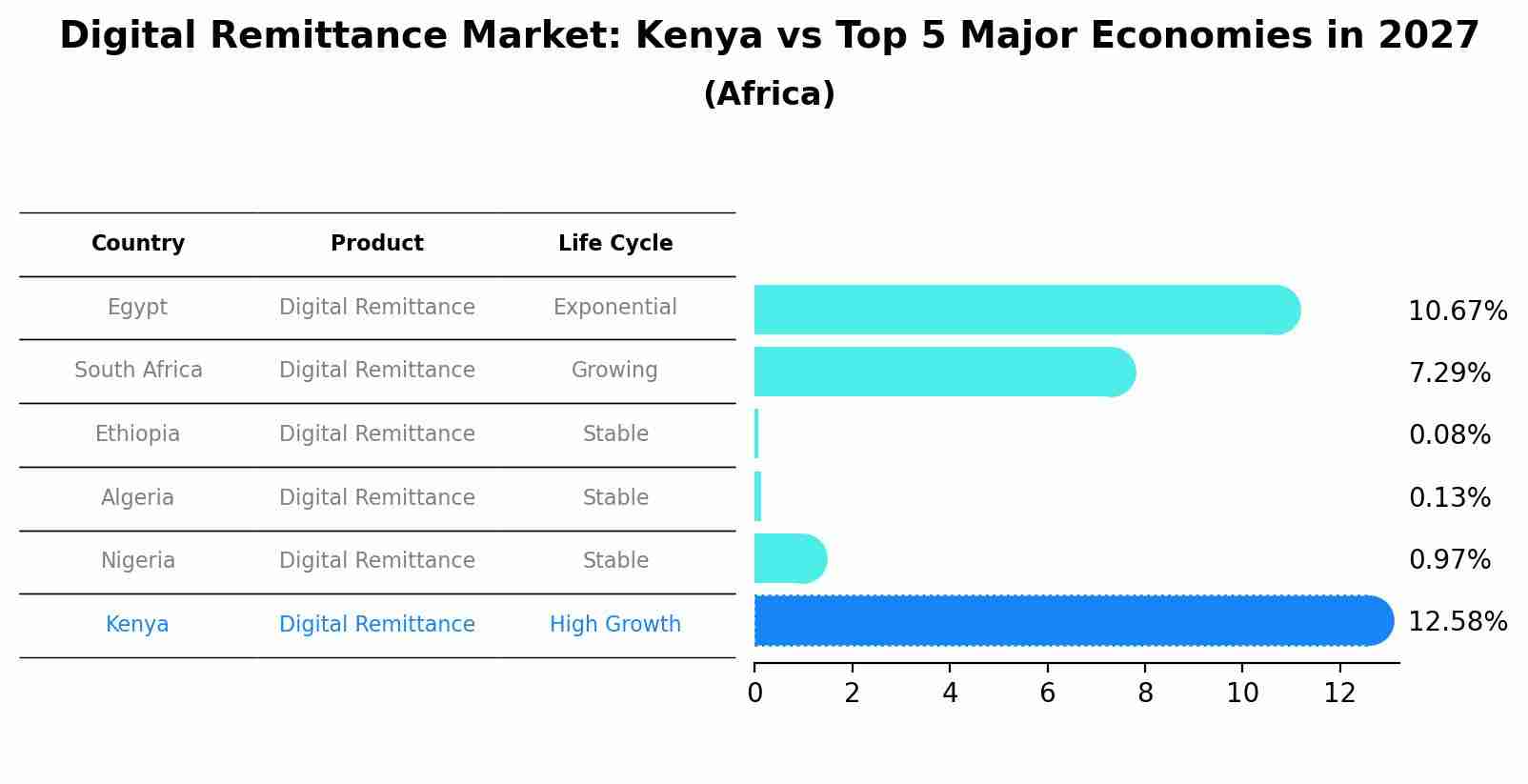Kenya Digital Remittance Market Outlook | Analysis, Growth, Size, Value, Forecast, COVID-19 IMPACT, Trends, Share, Industry, Revenue & Companies
| Product Code: ETC420766 | Publication Date: Oct 2022 | Updated Date: Apr 2025 | Product Type: Market Research Report | |
| Publisher: 6Wresearch | No. of Pages: 75 | No. of Figures: 35 | No. of Tables: 20 | |
Kenya Digital Remittance Market Size Growth Rate
The Kenya Digital Remittance Market is projected to witness mixed growth rate patterns during 2025 to 2029. Growth accelerates to 12.66% in 2026, following an initial rate of 11.68%, before easing to 6.35% at the end of the period.

Digital Remittance Market: Kenya vs Top 5 Major Economies in 2027 (Africa)
Kenya's Digital Remittance market is anticipated to experience a high growth rate of 12.58% by 2027, reflecting trends observed in the largest economy Egypt, followed by South Africa, Ethiopia, Algeria and Nigeria.

Kenya Digital Remittance Market Overview
In Kenya, the digital remittance market is witnessing rapid growth as the country`s diaspora population and migrant workers rely on digital channels to send money home to their families and loved ones. Digital remittance services offer convenient, secure, and cost-effective ways to transfer funds across borders using mobile wallets, online platforms, and digital payment networks. With the increasing penetration of smartphones, internet connectivity, and mobile money services, there is a rising adoption of digital remittance solutions in Kenya. Key players in the market are offering mobile remittance apps, online money transfer platforms, and partnership agreements with banks and payment providers to facilitate cross-border transactions and financial inclusion in Kenya digital economy.
Drivers of the market
Rising migrant population, increasing adoption of digital payment solutions, and growing demand for fast and cost-effective remittance services drive the digital remittance market in Kenya. Digital remittance platforms offer convenience, security, and lower transaction fees compared to traditional remittance channels, fostering market growth.
Challenges of the market
The Digital Remittance market encounters obstacles such as regulatory compliance, transaction costs, and competition from informal channels. While digital remittance platforms offer convenience and cost-effectiveness compared to traditional methods, regulatory requirements and transaction fees can impact adoption. Building trust among users and complying with regulations while offering competitive pricing are key challenges for digital remittance providers in Kenya.
Government Policy of the market
Recognizing the importance of remittances in supporting household incomes and promoting financial inclusion, Kenya has introduced policies to promote the adoption of digital remittance technologies. By facilitating regulatory reforms, fostering competition and innovation in the remittance market, and promoting partnerships between financial institutions and technology providers, the government aims to reduce transaction costs, enhance transparency, and improve access to remittance services for individuals and families across the country.
Key Highlights of the Report:
- Kenya Digital Remittance Market Outlook
- Market Size of Kenya Digital Remittance Market, 2021
- Forecast of Kenya Digital Remittance Market, 2028
- Historical Data and Forecast of Kenya Digital Remittance Revenues & Volume for the Period 2018 - 2028
- Kenya Digital Remittance Market Trend Evolution
- Kenya Digital Remittance Market Drivers and Challenges
- Kenya Digital Remittance Price Trends
- Kenya Digital Remittance Porter's Five Forces
- Kenya Digital Remittance Industry Life Cycle
- Historical Data and Forecast of Kenya Digital Remittance Market Revenues & Volume By Type for the Period 2018 - 2028
- Historical Data and Forecast of Kenya Digital Remittance Market Revenues & Volume By Inward Digital Remittance for the Period 2018 - 2028
- Historical Data and Forecast of Kenya Digital Remittance Market Revenues & Volume By Outward Digital Remittance for the Period 2018 - 2028
- Historical Data and Forecast of Kenya Digital Remittance Market Revenues & Volume By Channel for the Period 2018 - 2028
- Historical Data and Forecast of Kenya Digital Remittance Market Revenues & Volume By Banks for the Period 2018 - 2028
- Historical Data and Forecast of Kenya Digital Remittance Market Revenues & Volume By Money Transfer Operators for the Period 2018 - 2028
- Historical Data and Forecast of Kenya Digital Remittance Market Revenues & Volume By Online Platforms for the Period 2018 - 2028
- Historical Data and Forecast of Kenya Digital Remittance Market Revenues & Volume By Others for the Period 2018 - 2028
- Historical Data and Forecast of Kenya Digital Remittance Market Revenues & Volume By End-use for the Period 2018 - 2028
- Historical Data and Forecast of Kenya Digital Remittance Market Revenues & Volume By Migrant Labor Workforce for the Period 2018 - 2028
- Historical Data and Forecast of Kenya Digital Remittance Market Revenues & Volume By Personal for the Period 2018 - 2028
- Historical Data and Forecast of Kenya Digital Remittance Market Revenues & Volume By Small Businesses for the Period 2018 - 2028
- Historical Data and Forecast of Kenya Digital Remittance Market Revenues & Volume By Others for the Period 2018 - 2028
- Kenya Digital Remittance Import Export Trade Statistics
- Market Opportunity Assessment By Type
- Market Opportunity Assessment By Channel
- Market Opportunity Assessment By End-use
- Kenya Digital Remittance Top Companies Market Share
- Kenya Digital Remittance Competitive Benchmarking By Technical and Operational Parameters
- Kenya Digital Remittance Company Profiles
- Kenya Digital Remittance Key Strategic Recommendations
Frequently Asked Questions About the Market Study (FAQs):
1 Executive Summary |
2 Introduction |
2.1 Key Highlights of the Report |
2.2 Report Description |
2.3 Market Scope & Segmentation |
2.4 Research Methodology |
2.5 Assumptions |
3 Kenya Digital Remittance Market Overview |
3.1 Kenya Country Macro Economic Indicators |
3.2 Kenya Digital Remittance Market Revenues & Volume, 2021 & 2028F |
3.3 Kenya Digital Remittance Market - Industry Life Cycle |
3.4 Kenya Digital Remittance Market - Porter's Five Forces |
3.5 Kenya Digital Remittance Market Revenues & Volume Share, By Type, 2021 & 2028F |
3.6 Kenya Digital Remittance Market Revenues & Volume Share, By Channel, 2021 & 2028F |
3.7 Kenya Digital Remittance Market Revenues & Volume Share, By End-use, 2021 & 2028F |
4 Kenya Digital Remittance Market Dynamics |
4.1 Impact Analysis |
4.2 Market Drivers |
4.3 Market Restraints |
5 Kenya Digital Remittance Market Trends |
6 Kenya Digital Remittance Market, By Types |
6.1 Kenya Digital Remittance Market, By Type |
6.1.1 Overview and Analysis |
6.1.2 Kenya Digital Remittance Market Revenues & Volume, By Type, 2018 - 2028F |
6.1.3 Kenya Digital Remittance Market Revenues & Volume, By Inward Digital Remittance, 2018 - 2028F |
6.1.4 Kenya Digital Remittance Market Revenues & Volume, By Outward Digital Remittance, 2018 - 2028F |
6.2 Kenya Digital Remittance Market, By Channel |
6.2.1 Overview and Analysis |
6.2.2 Kenya Digital Remittance Market Revenues & Volume, By Banks, 2018 - 2028F |
6.2.3 Kenya Digital Remittance Market Revenues & Volume, By Money Transfer Operators, 2018 - 2028F |
6.2.4 Kenya Digital Remittance Market Revenues & Volume, By Online Platforms, 2018 - 2028F |
6.2.5 Kenya Digital Remittance Market Revenues & Volume, By Others, 2018 - 2028F |
6.3 Kenya Digital Remittance Market, By End-use |
6.3.1 Overview and Analysis |
6.3.2 Kenya Digital Remittance Market Revenues & Volume, By Migrant Labor Workforce, 2018 - 2028F |
6.3.3 Kenya Digital Remittance Market Revenues & Volume, By Personal, 2018 - 2028F |
6.3.4 Kenya Digital Remittance Market Revenues & Volume, By Small Businesses, 2018 - 2028F |
6.3.5 Kenya Digital Remittance Market Revenues & Volume, By Others, 2018 - 2028F |
7 Kenya Digital Remittance Market Import-Export Trade Statistics |
7.1 Kenya Digital Remittance Market Export to Major Countries |
7.2 Kenya Digital Remittance Market Imports from Major Countries |
8 Kenya Digital Remittance Market Key Performance Indicators |
9 Kenya Digital Remittance Market - Opportunity Assessment |
9.1 Kenya Digital Remittance Market Opportunity Assessment, By Type, 2021 & 2028F |
9.2 Kenya Digital Remittance Market Opportunity Assessment, By Channel, 2021 & 2028F |
9.3 Kenya Digital Remittance Market Opportunity Assessment, By End-use, 2021 & 2028F |
10 Kenya Digital Remittance Market - Competitive Landscape |
10.1 Kenya Digital Remittance Market Revenue Share, By Companies, 2021 |
10.2 Kenya Digital Remittance Market Competitive Benchmarking, By Operating and Technical Parameters |
11 Company Profiles |
12 Recommendations |
13 Disclaimer |
- Single User License$ 1,995
- Department License$ 2,400
- Site License$ 3,120
- Global License$ 3,795
Search
Related Reports
- Portugal Occupational Health & Safety Services Market (2025-2031) | Strategy, Consumer Insights, Analysis, Investment Trends, Opportunities, Growth, Size, Share, Industry, Revenue, Segments, Value, Segmentation, Supply, Forecast, Restraints, Outlook, Competition, Drivers, Trends, Demand, Pricing Analysis, Competitive, Strategic Insights, Companies, Challenges
- Netherlands Occupational Health and Safety Services Market (2025-2031) | Strategy, Consumer Insights, Analysis, Investment Trends, Opportunities, Growth, Size, Share, Industry, Revenue, Segments, Value, Segmentation, Supply, Forecast, Restraints, Outlook, Competition, Drivers, Trends, Demand, Pricing Analysis, Competitive, Strategic Insights, Companies, Challenges
- Belgium and Luxembourg Facility Management Market (2025-2031) | Strategy, Consumer Insights, Analysis, Investment Trends, Opportunities, Growth, Size, Share, Industry, Revenue, Segments, Value, Segmentation, Supply, Forecast, Restraints, Outlook, Competition, Drivers, Trends, Demand, Pricing Analysis, Competitive, Strategic Insights, Companies, Challenges
- Russia Women Intimate Apparel Market (2025-2031) | Strategy, Consumer Insights, Analysis, Investment Trends, Opportunities, Growth, Size, Share, Industry, Revenue, Segments, Value, Segmentation, Supply, Forecast, Restraints, Outlook, Competition, Drivers, Trends, Demand, Pricing Analysis, Competitive, Strategic Insights, Companies, Challenges
- Africa Chocolate Market (2025-2031) | Size, Share, Trends, Growth, Revenue, Analysis, Forecast, industry & Outlook
- Global Hydroxychloroquine And Chloroquine Market (2025-2031) | Industry, Trends, Size, Outlook, Growth, Value, Companies, Revenue, Analysis, Share, Forecast
- Saudi Arabia Plant Maintenance Market (2025-2031) | Industry, Size, Growth, Revenue, Value, Companies, Forecast, Analysis, Share & Trends
- Taiwan Electric Truck Market (2025-2031) | Outlook, Industry, Revenue, Size, Forecast, Growth, Analysis, Share, Companies, Value & Trends
- South Korea Electric Bus Market (2025-2031) | Outlook, Industry, Companies, Analysis, Size, Revenue, Value, Forecast, Trends, Growth & Share
- Africa Low Temperature Powder Coating Market (2025-2031) | Companies, Competition, Size, Challenges, Segmentation, Trends, Competitive, Industry, Supply, Strategy, Investment Trends, Growth, Segments, Restraints, Strategic Insights, Revenue, Share, Forecast, Drivers, Analysis, Pricing Analysis, Demand, Consumer Insights, Value, Opportunities, Outlook
Industry Events and Analyst Meet
Our Clients
Whitepaper
- Middle East & Africa Commercial Security Market Click here to view more.
- Middle East & Africa Fire Safety Systems & Equipment Market Click here to view more.
- GCC Drone Market Click here to view more.
- Middle East Lighting Fixture Market Click here to view more.
- GCC Physical & Perimeter Security Market Click here to view more.
6WResearch In News
- Doha a strategic location for EV manufacturing hub: IPA Qatar
- Demand for luxury TVs surging in the GCC, says Samsung
- Empowering Growth: The Thriving Journey of Bangladesh’s Cable Industry
- Demand for luxury TVs surging in the GCC, says Samsung
- Video call with a traditional healer? Once unthinkable, it’s now common in South Africa
- Intelligent Buildings To Smooth GCC’s Path To Net Zero













